Rickubis Bird Page #7: Vultures!
This
page was born 04/16/2015. Rickubis designed it.
(such as it
is.) Last update: 04/03/2022
Images
and contents on this page copyright ©2002-2022 Richard M. Dashnau
Go back to my
home page, Welcome
to rickubis.com
Go
back to the RICKUBISCAM
page.
----------------------------------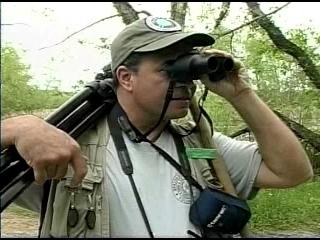
Welcome
to Brazos Bend State Park. That's me on the trail. One of the most
popular
reasons for people to visit BBSP is to see the birds. Although *I*
started
going to the park mainly for the alligators, one
cannot be there for long
without learning to enjoy the birds. Over the years, I've captured a
few
pictures and video clips of them, and here they are. I've collected
all
my shots of vultures onto this page.
04/04/2021 Back
to Brazos Bend State Park! It was great to be out on the trail and
interpreting Nature for interested visitors. It was Easter Sunday,
which is usually one of
our busiest days, so I was on my bicycle.
While this lets me cover more trails, it cuts down on what I
can
see. However, that doesn't mean I missed everything.
At
Creekfield Lake, I saw these Black Vultures (Coragyps atratus) at the
platform at the end of the long pier. Although it was tempting to get
closer, I let them be-so they could
enjoy the early morning (about
8am) like I was. This species often picks a "roost tree" in
this
area, and groups of 20 or more can sometimes be seen in the morning.
It's amazing to
see a group them take off and ride a column of
heated air before they separate for to forage. It's also fun
to
see them coming in to roost for the evening as a huge number of these
large
birds come in to a huge column and then descend to the trees. I've
tried to film both times, but I can't capture the tremendous scale of
these events.
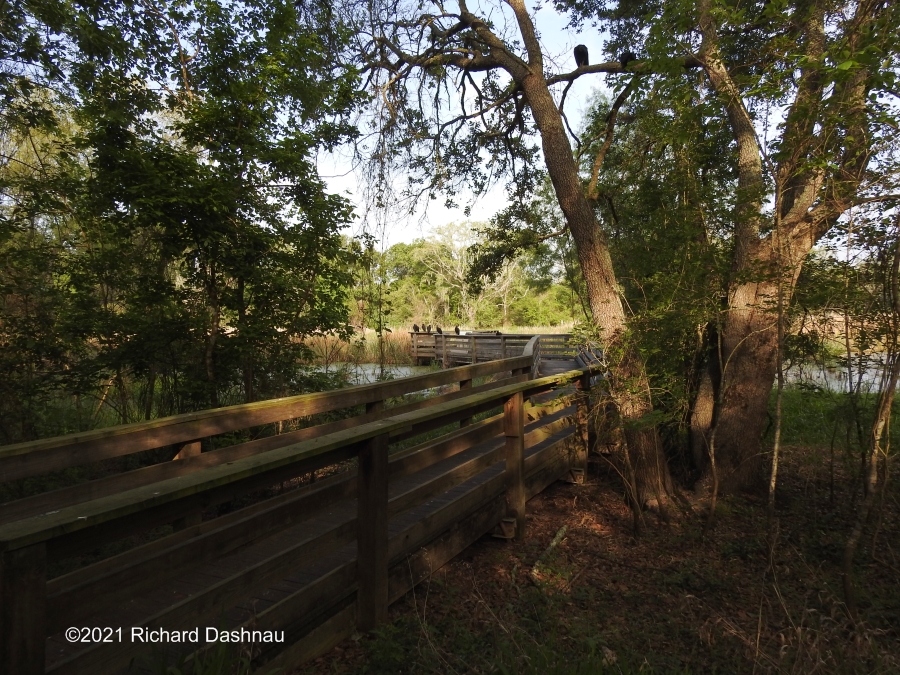
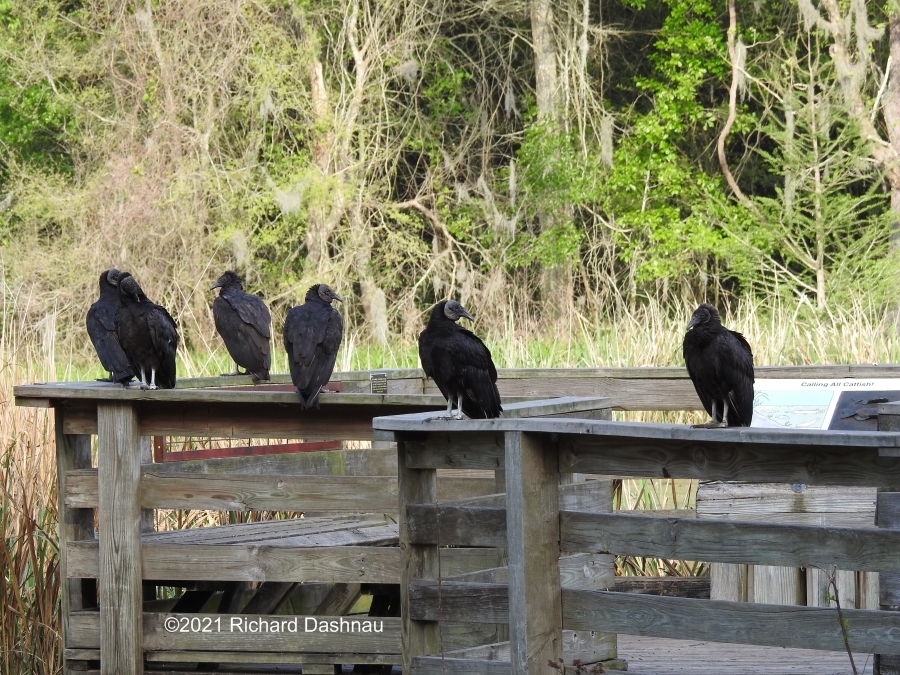
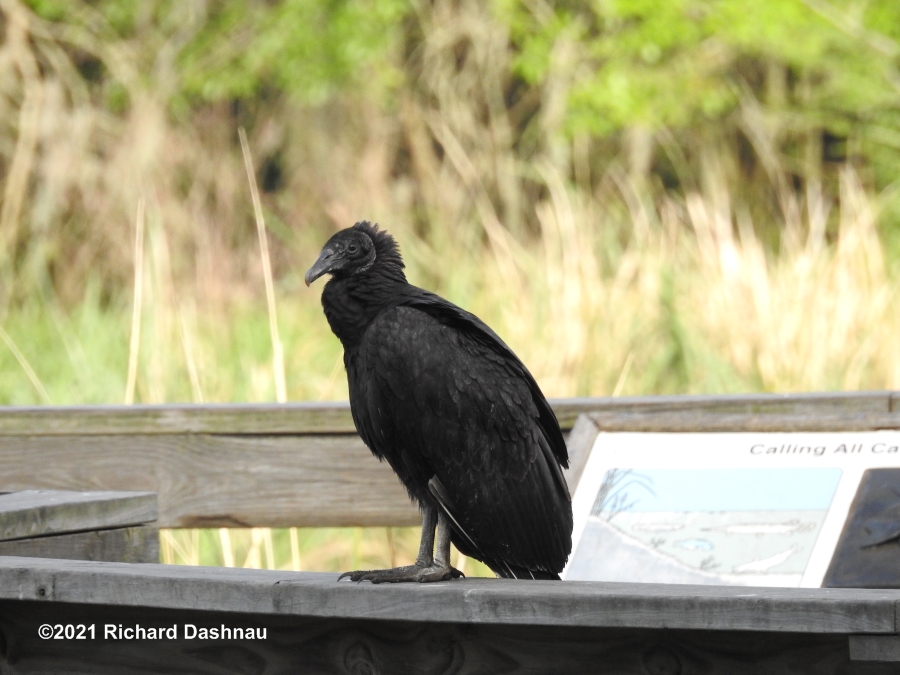
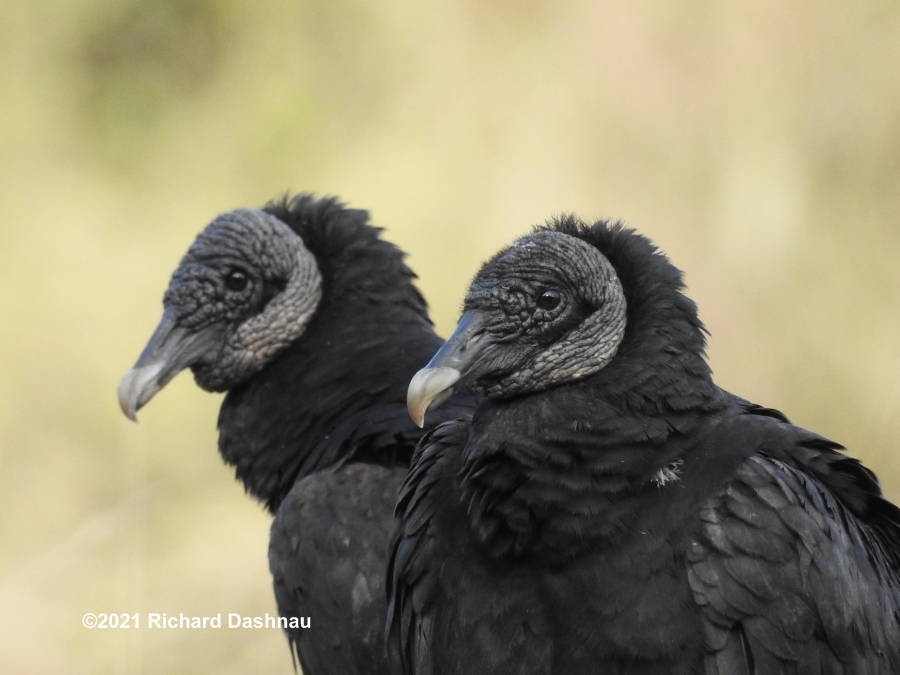
01/09/2021
I've
been going to Fiorenza park more often lately. It's not too far from my
home (about 20 minutes' drive) and very few people are there when I am.
As usual for the winter
months, many White Pelicans and
Cormorants appear there. I really enjoy seeing them forage
together in large rafts, and have taken a number of photos and video
clips over the last few weeks.
Today I saw a group
of Black Vultures (Coragyps atratus). I always
like to watch them, so I got some photos and video clips.
The
morning was chilly so some of them opened their
wings and turned
their backs to the sun to warm up. I captured high frame
rate
video of 2 different vultures taking off. The last photo
below
is a frame from that
edited
video (mp4).
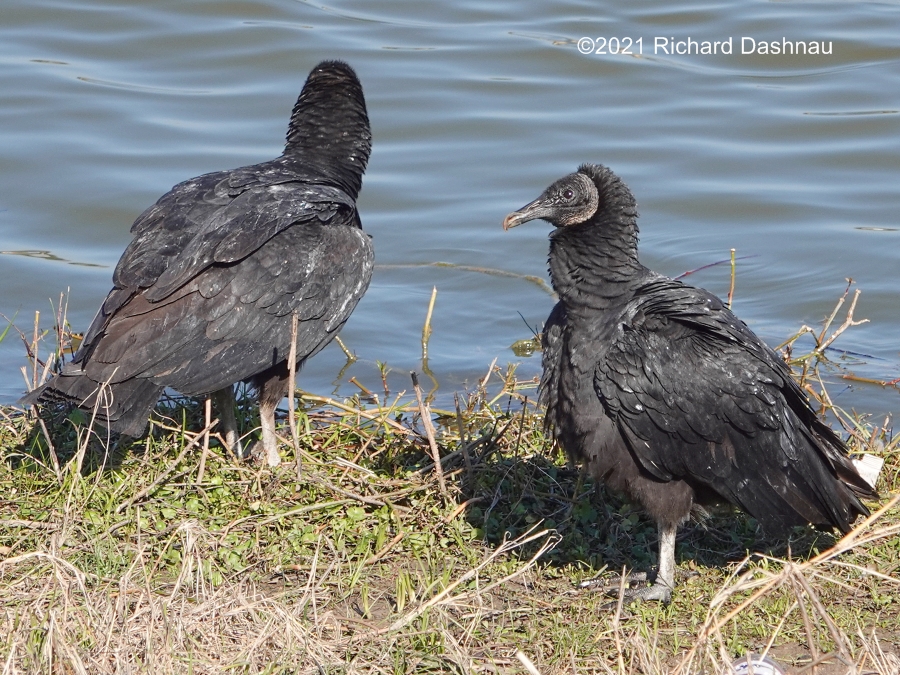
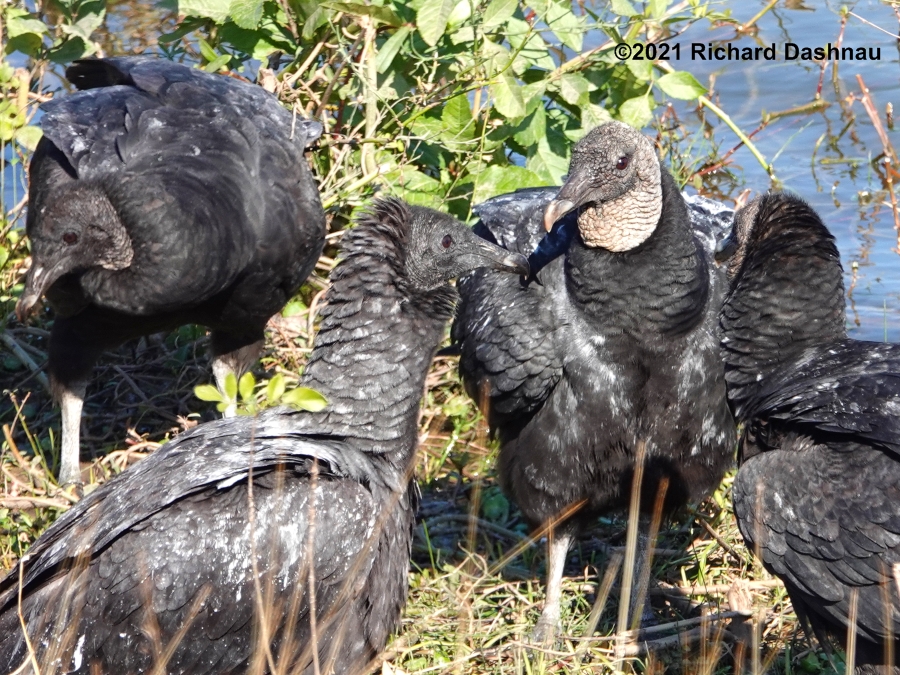
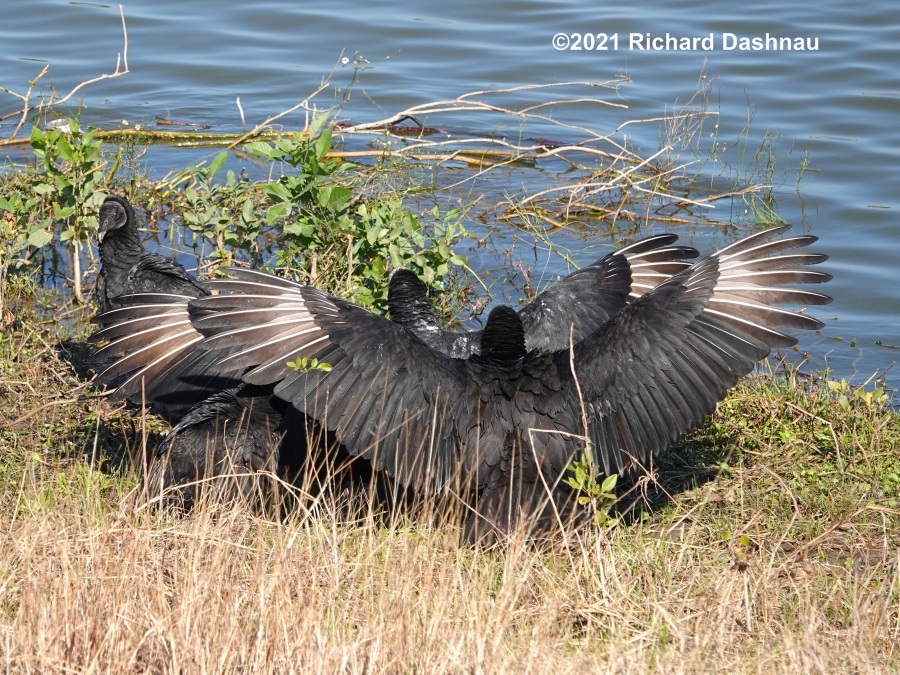
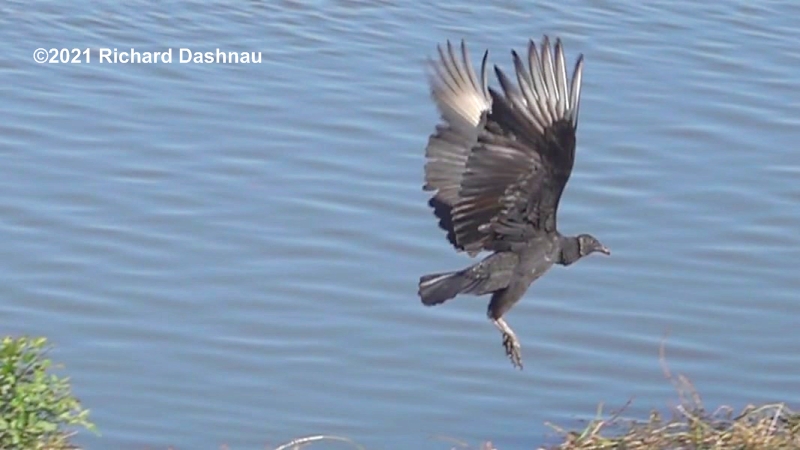
Vultures relax by the water
Facing each other
Catching
some sun.
Taking
off!
I
found the reason that the vultures had collected there. There
carrion
down by the water, and they were picking at it.
Since I
didn't want to chase them off, I stayed back (about 50 yards away)
and
zoomed in with the camera to try to identify the carcass.. I
noticed that the skull had sharp teeth, without large orange
incisors.
So, not a nutria or other rodent. I thought I could see a
long,
naked
tail. That, with the sharp teeth the pale color of the carcass
made me
think it might be an opossum. I've seen vultures take
carrion
away, so I didn't want to risk moving closer. The vultures
finally
flew off and left the carcass, so I could examine it. My
first
guess was wrong. The skull was short, and I could see the ears.
The
carcass was that of a cat.
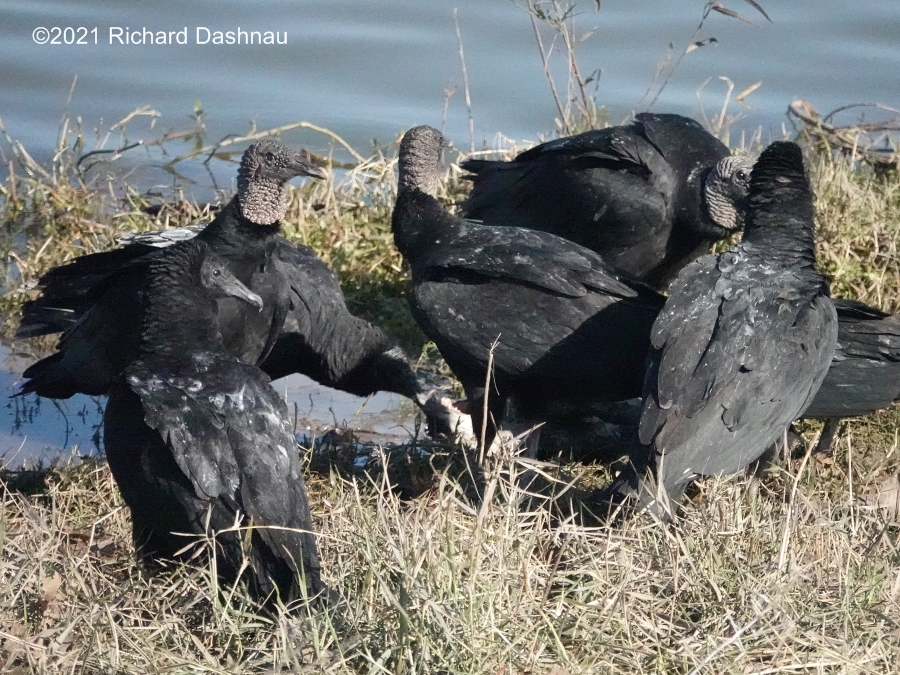
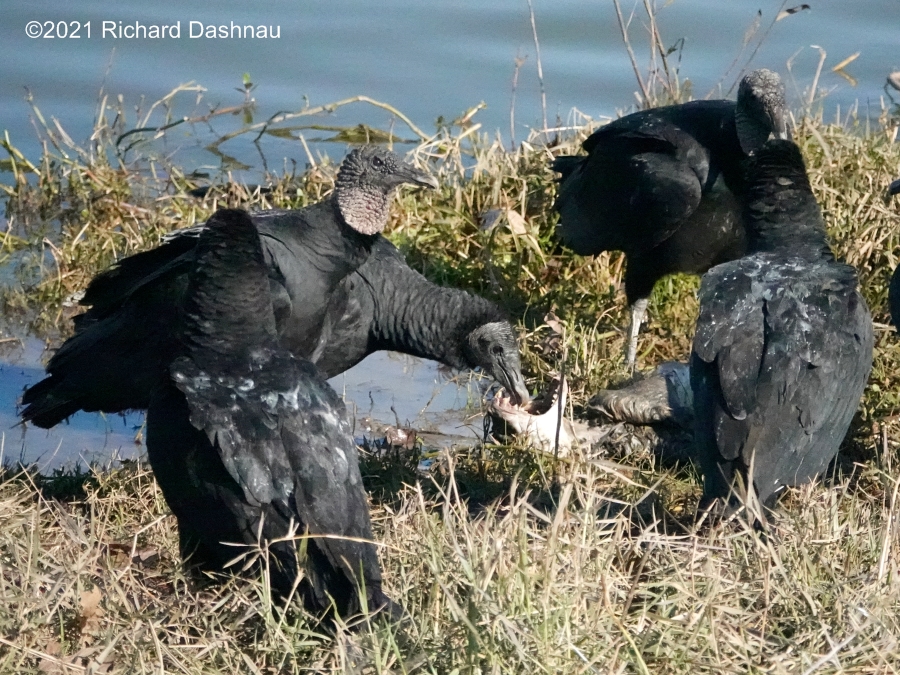
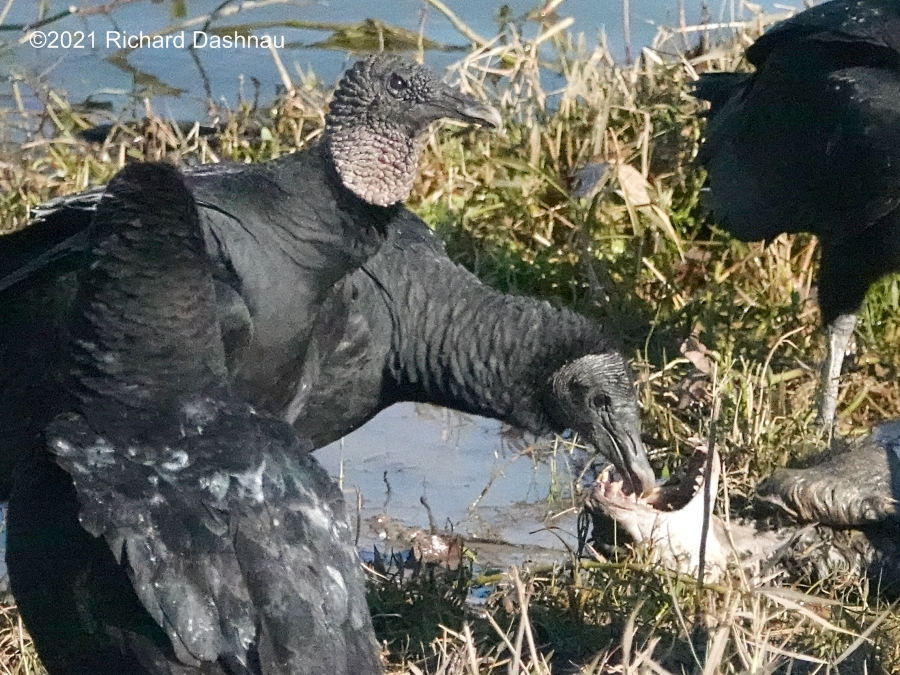
Vultures gathered around
carcass
Sharp teeth, not big incisors
Closer
look at those teeth.
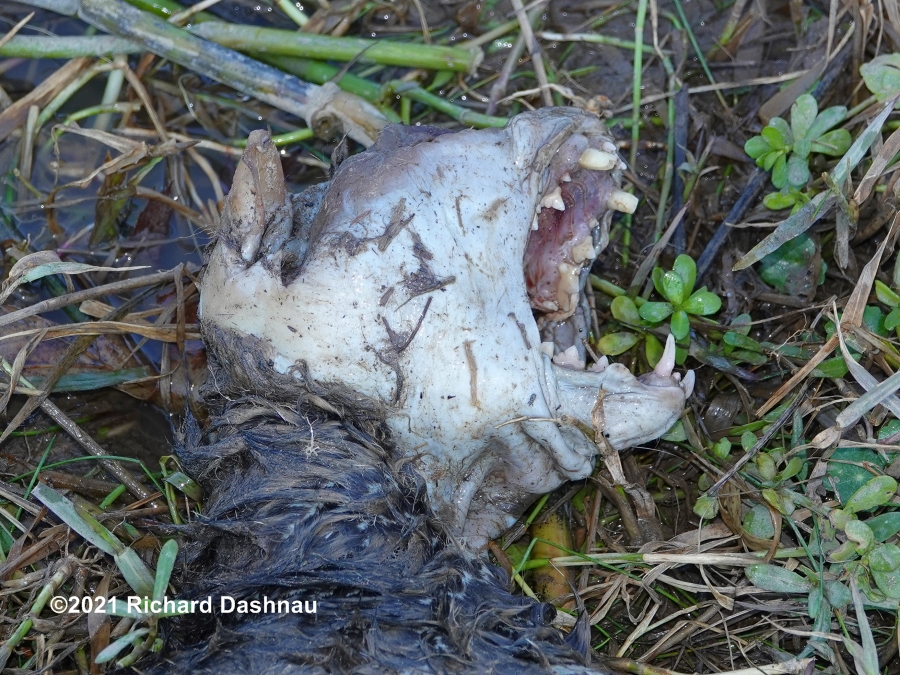
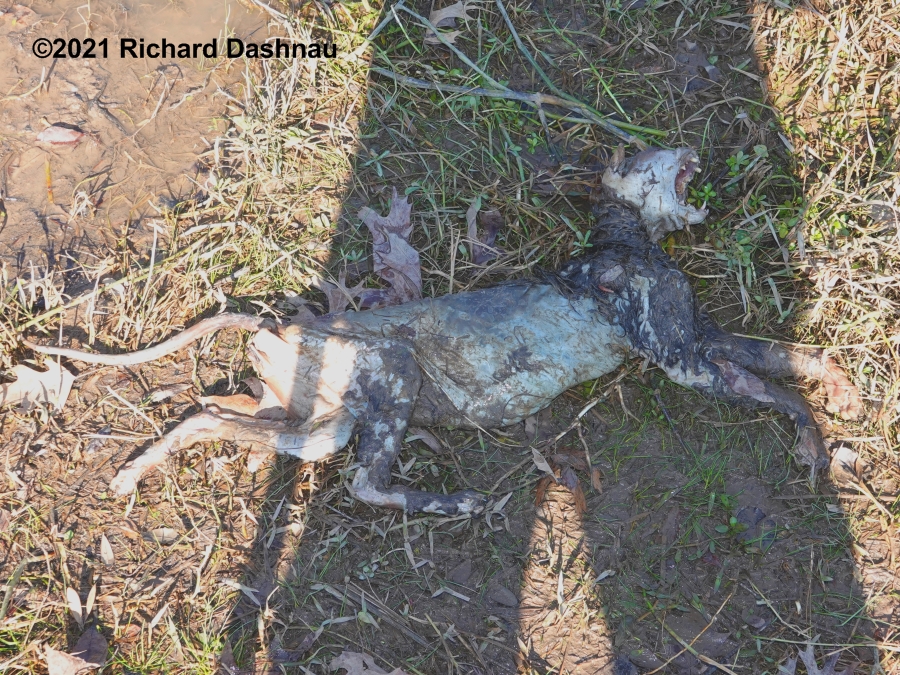
Short
skull, sharp teeth, pointed ears, long tail.
The
ponds
at Archbishop Fiorenza Park were built as water detention ponds
to help control the flow of water from Brays Bayou. I've
found
reference online to
an Eldridge Stormwater Detention Basin for this area. (I've
finally
found a webpage
about
this portion of the park! If the link survives.)
Over the last week or so, we'd gotten enough
rain to raise the level of
those ponds about 4 feet. That carcass could have come from
anywhere upstream along Brays Bayou. The images (and this
video
of
the vultures feeding (mp4))
may upset some people, but I've chosen to share this. In part, I
wanted
to share how I'd discovered what it was. Also, this illustrates
an
issue that is often being discussed. Regardless of whether
this cat had been someone's pet (and there was no collar);
or
if it had
been feral (it certainly wasn't a bobcat-it
had long tail.) on that
morning, it was just vulture food. It does no good to let
the
domesticated species of cat run loose in the wild.
12/24/2018
I went out to Fiorenza park as I often do. I was hoping to see a
Bald
Eagle, but of course many other birds show up there. I was on
the East
elevated
section--near the bridge to the West elevated section when I
noticed
large black birds on the grass about 100 yards away. When I
looked
through
binoculars, I saw Vultures...but I also so a bird with a
white head. But, it wasn't a Bald Eagle--it was a Crested
Caracara.
Since they were clustered around
something on the grass, I assumed
that they had found something to eat...such as a carcass. I'd
read that
Caracaras competed with Vultures for carrion.
and I thought this was
a chance to watch them together. So, I hurried down the hill,
across
the bridge, and back up the hill to where I could see the
Vultures. Then I started shooting video.
I
only watched the birds for about 15 minutes--but a lot happened
during
that time. I watched the Caracara (Caracara cheriway) as it
chased a
group
of Turkey Vultures (Cathartes aura) AND a group of Black
Vultures (Coragyps atratus) away from the carcass. I
couldn't
tell
what the carcass had been.
I also watched as the Vultures tried various non-violent ploys
to get
some of that carrion.
I
shoot my "normal" video at 60fps, and 1920 x 1080 resolution.
This allows me to easily slow the video to 30 fps (1/2
speed)
and
keep smooth video playback.
And, I can crop the video to enhance
details I want to show. From my video clips, I've
put
together a video that just under 15 minutes long. The three
images
below are frame grabs from the video
clips. the video is linked
here. I had a wonderful time watching these
majestic birds!!
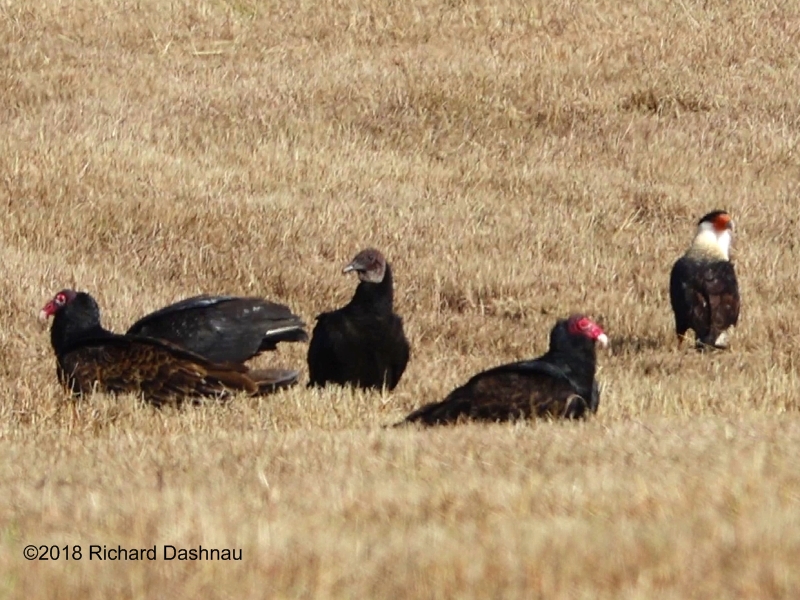
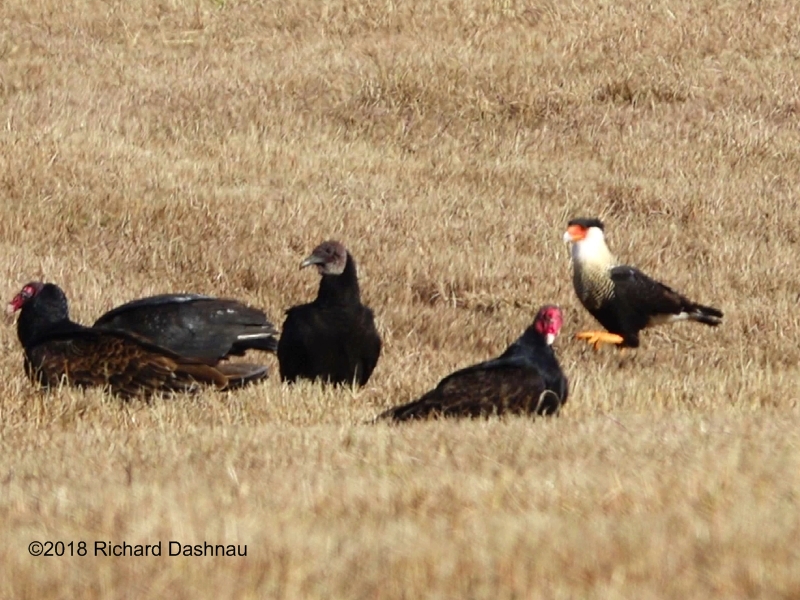
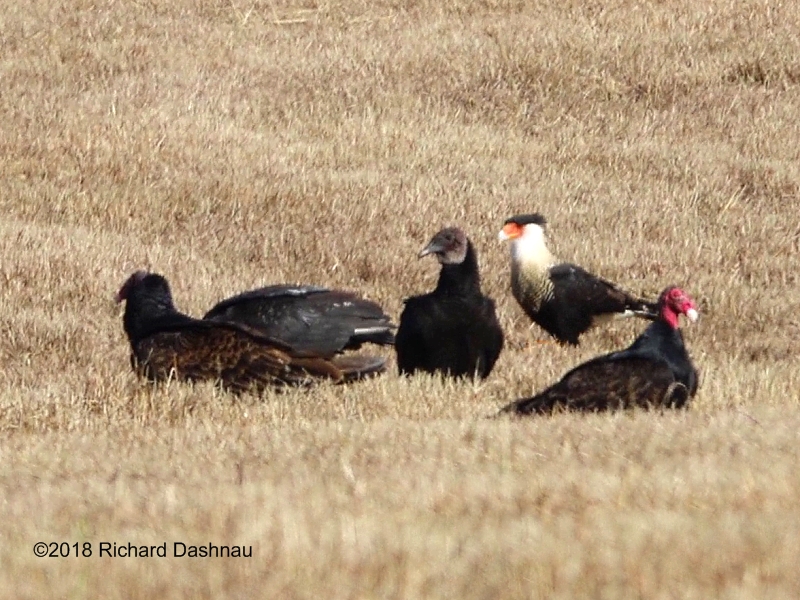
11/04/2018
While Walking near the 40 Acre Lake Observation Tower, I noticed
some
Black Vultures on the trail to the South. When I moved a bit
closer,
I
saw that they seemed to be gathered around an alligator that was
in the grass, between the trail and the lake. I thought that was
odd,
and briefly thought that
they might have gathered around a dead
alligator. When I remembered that a few people had passed that
way, and
none of them had mentioned a dead
gator, I realized that I was probably mistaken. I
moved a little closer, but still remained about 50 yards away.
Then I
watched vultures through binoculars and
my camera. After a few
minutes, the alligator slid into the center of the path,which
placed it
among the vultures. Well, that proved it wasn't dead! Most of
the
images
below are frame grabs from video clips I shot during this event.
I've
edited them together into a single video file that can be seen
at this
link.
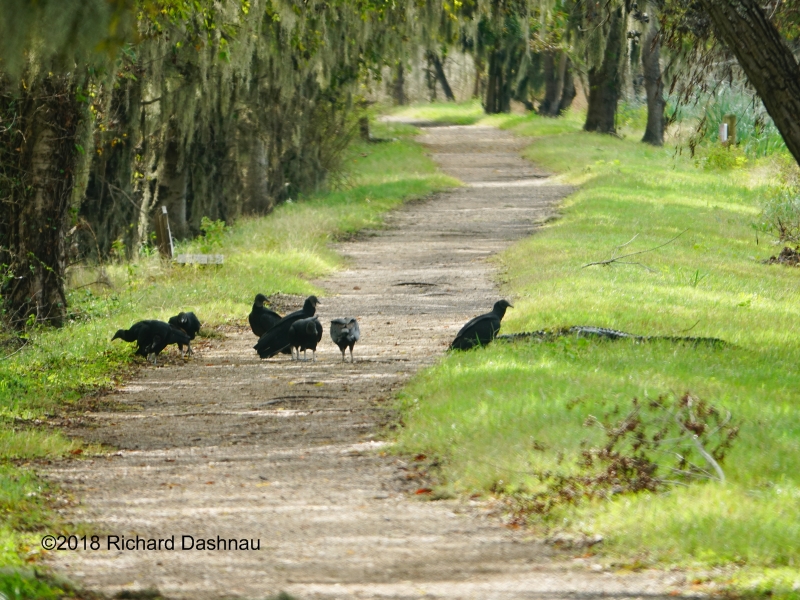
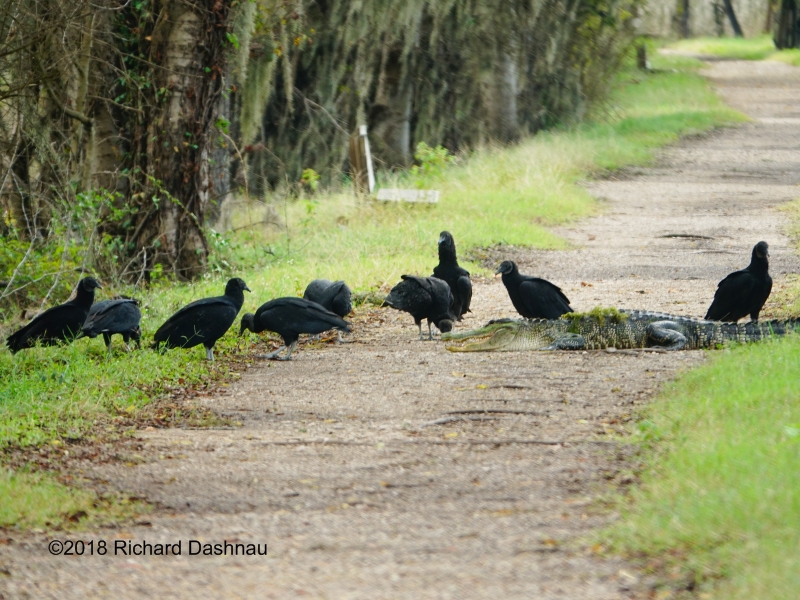
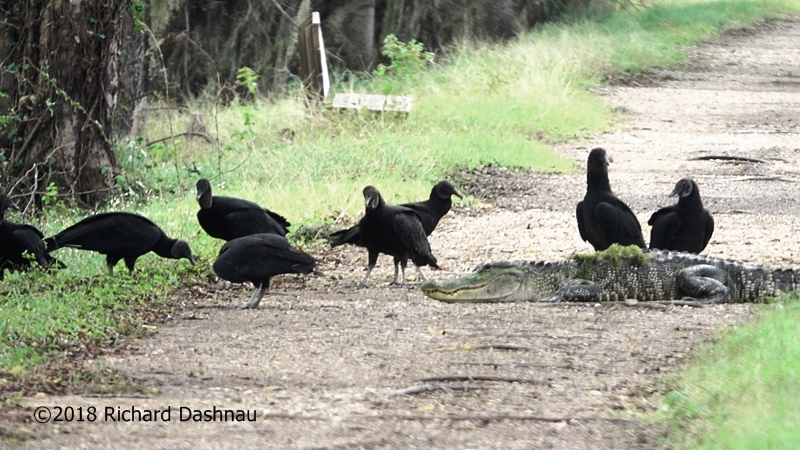
It
rested on the trail while the vultures stood around it. Finally,
it
stood, backed up, turned around and walked back into the
lake.
The vultures watched it go.
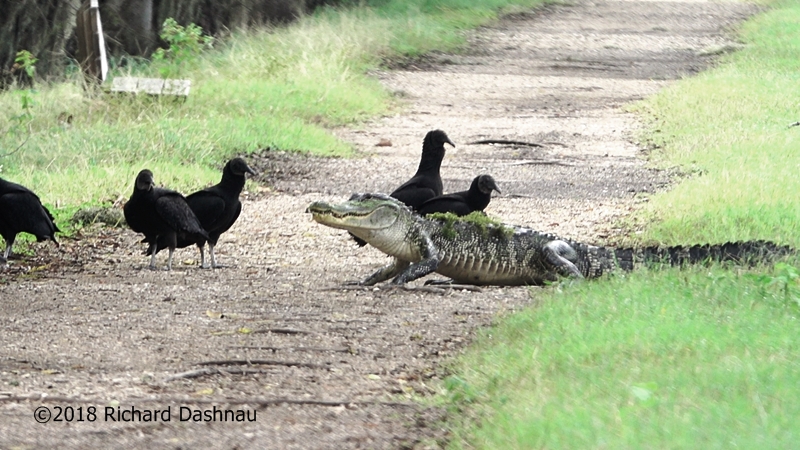
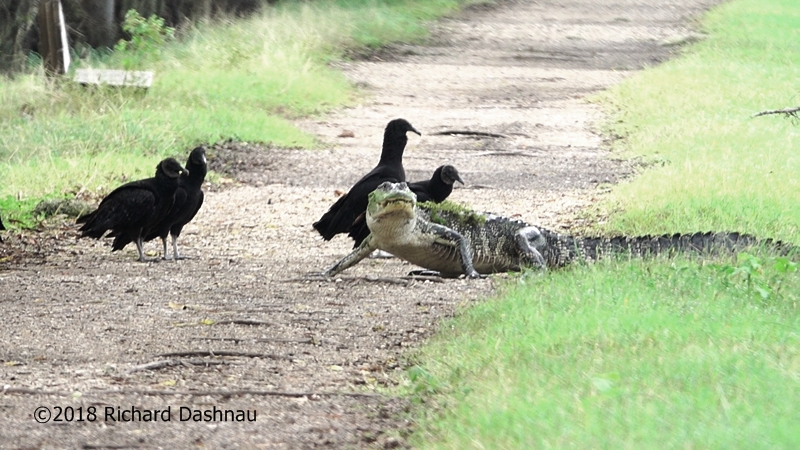
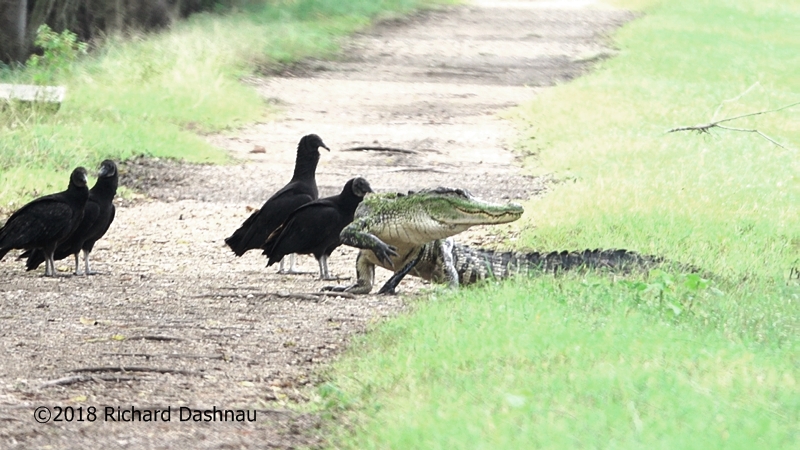
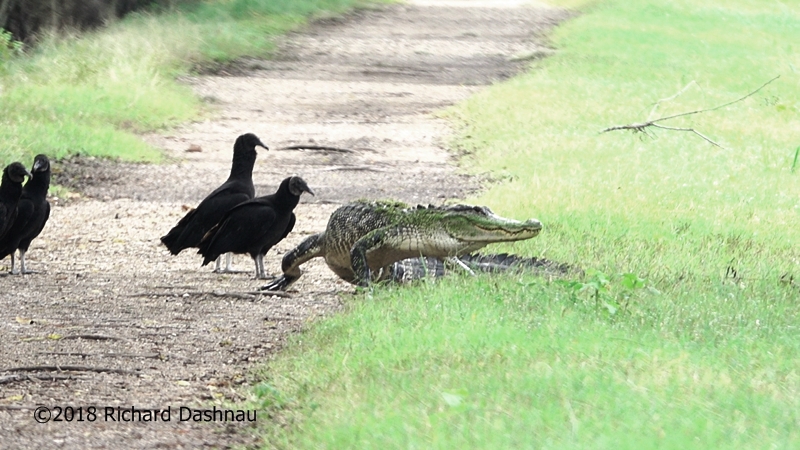
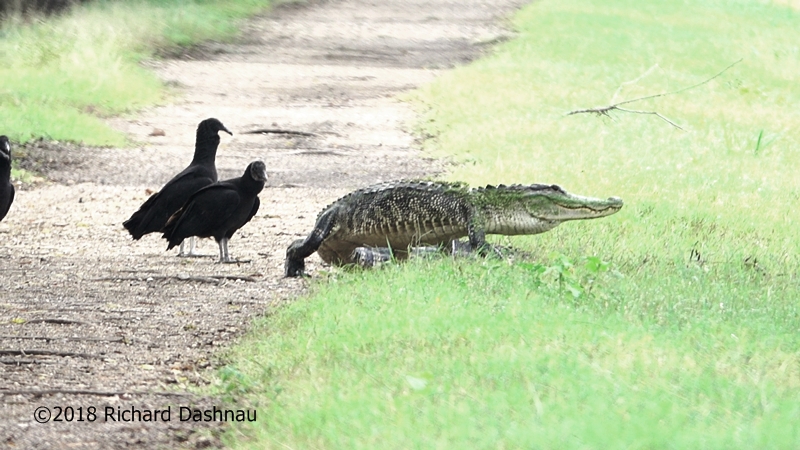

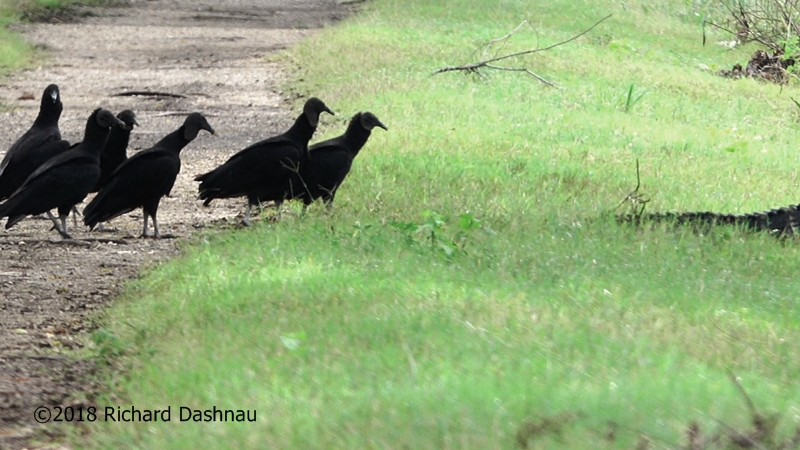
Right
after the alligator entered the water, a vulture pulled a
surprise out of the grass from the other side of the
trail! It appeared to be internal organs or
a mass of
something
else wet and soft. I watched the vultures as they poked at
the
mass, shared it, and argued over it. It's always interesting to
watch
them.
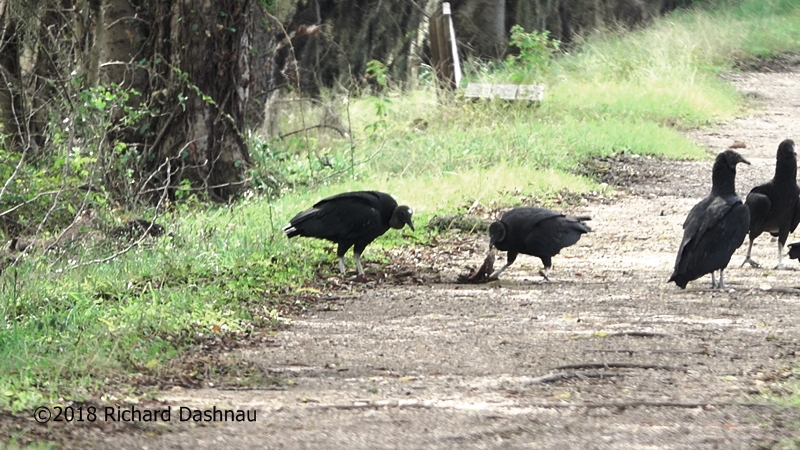
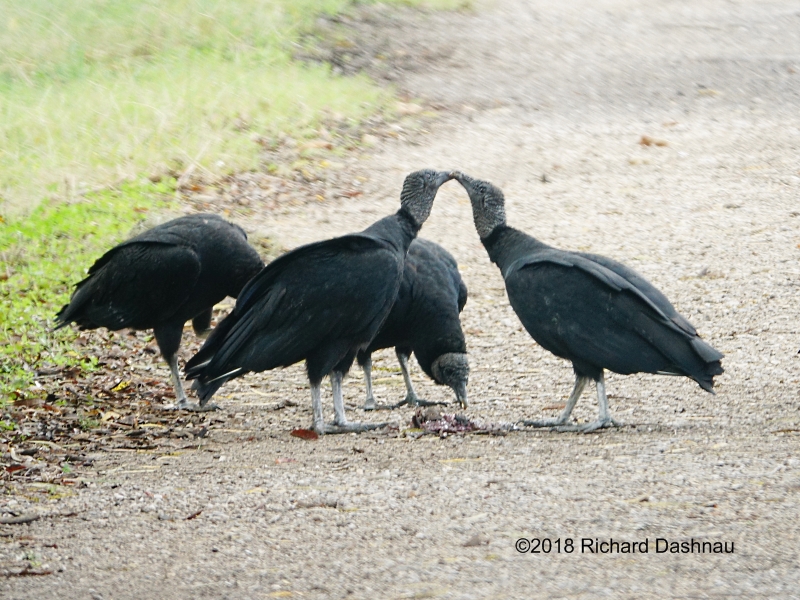
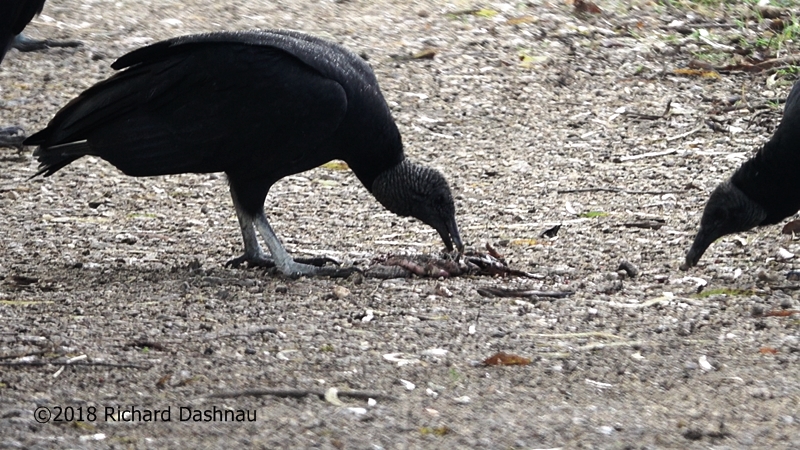
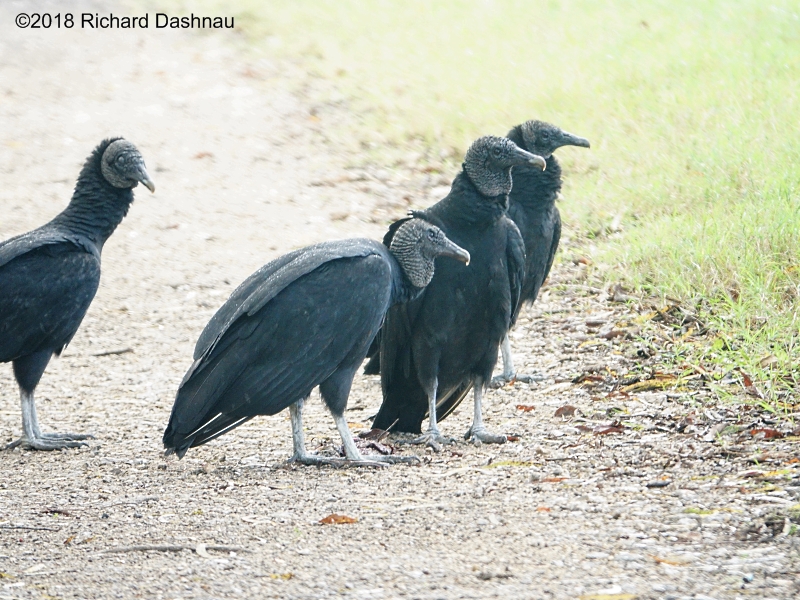
About
20 minutes after it had left, the alligator moved back out of
the water
and crawled slowly towards the vultures. As it moved
towards
the
trail, a few of
the vultures moved into an odd sideways stance
with wings partially opened, and walked back at an angle as the
alligator approached. The alligator slid to the
edge of the
trail, and paused. The vultures kept watch on the
alligator
as
they continued poking around on the trail.
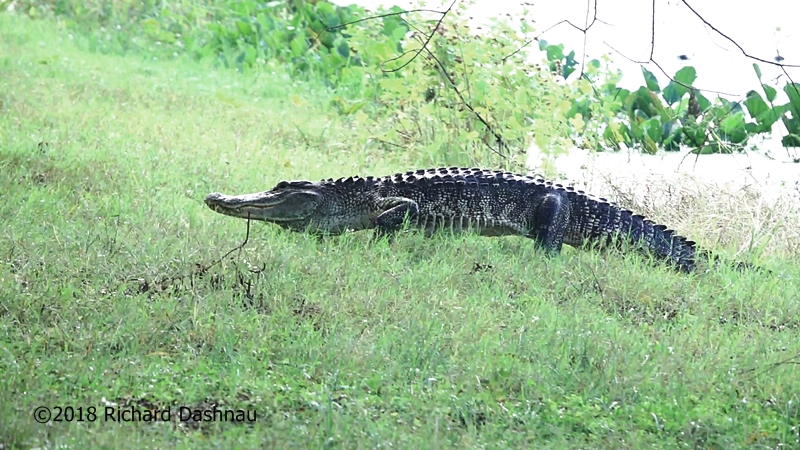
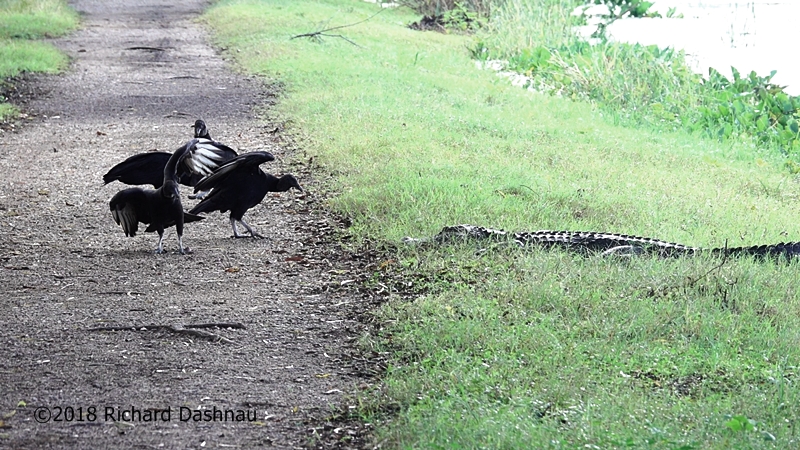
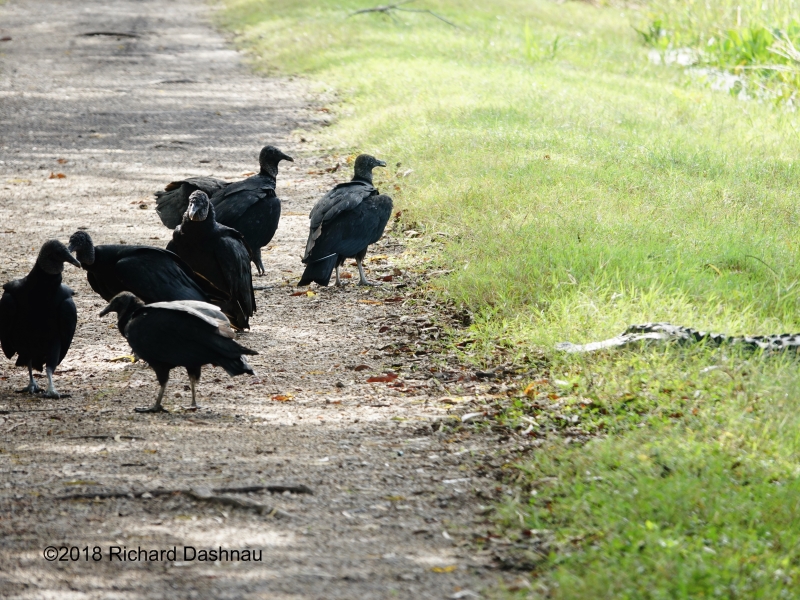
At
about this time, a couple of park visitors happened by. So, I
described
the situation to them. I did this partly because it's my
job
as a
nature interpreter; but I also
wanted to prevent the visitors from
continuing down the trail and disturbing the equilibrium of the
"confrontation". While I was talking to these visitors,
the
alligator suddenly opened its
jaws, and lunged a few steps towards
the vultures. The vultures did not seem very impressed by this
they
just moved aside and watched the alligator. The alligator
paused
with its mouth
slightly open, then turned and went back to the water.
Once
again, the vultures followed the alligator and watched it go.
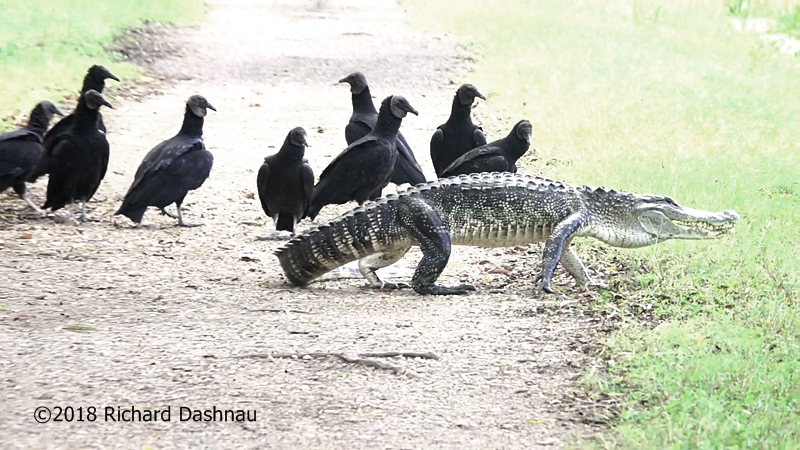
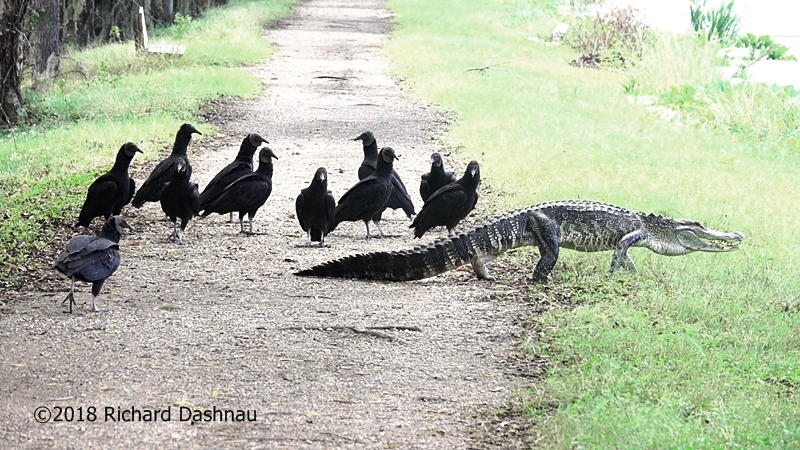

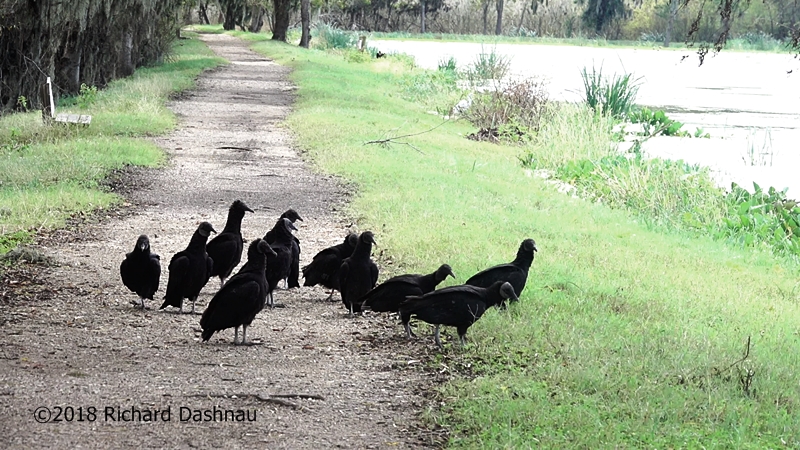
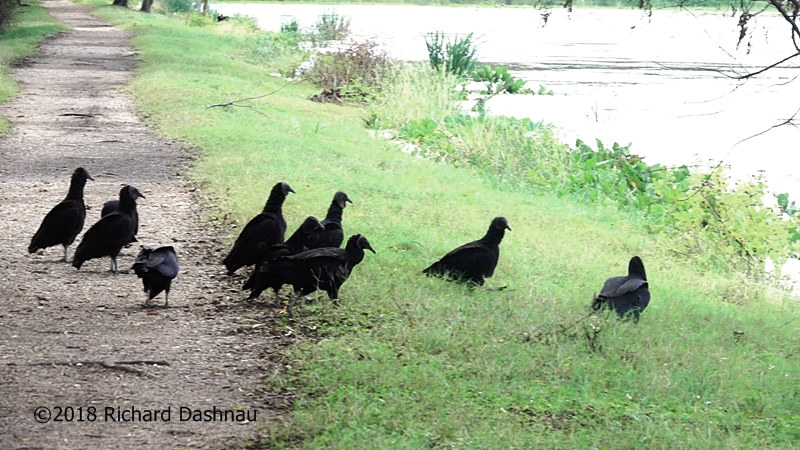
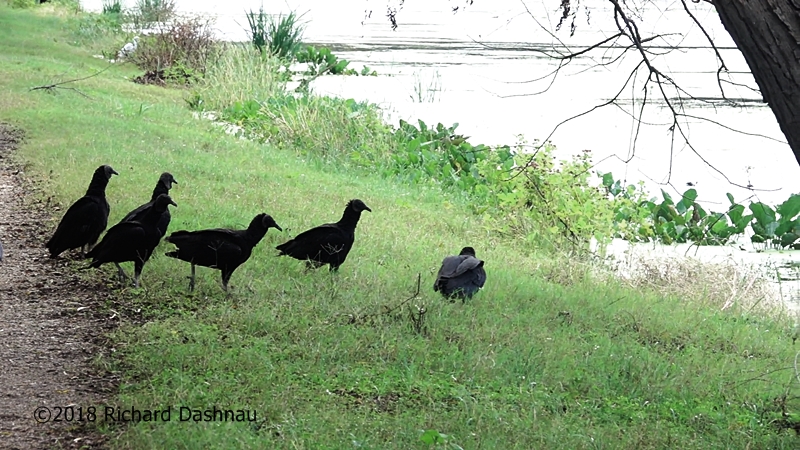
After a
while, the vultures finally stopped arguing over whatever
the mass was, and finally dispersed.
Although
commonly considered scavengers, Black Vultures will sometimes
take live
prey, such as nestling herons, baby turtles, or even living
newborn
calves. (The
Sibley Guide to Bird
Behavior, 1st Edition, p. 184)
Various
online sources give evidence that flocks of Black Vultures can
be a nuisance, but that appears to be in places where the
vultures do
not normally live.
At Brazos Bend, they can be an awe-inspiring sight, or just an
object
of fascination.
And once again, the
video file for these events can be seen at this
link.
February
19, 2012 Consider a character
that eats
dead and rotting flesh. Imagine also that it never brushes its teeth.
It
doesn't take much to imagine that that character wouldn't be very
popular. So, our character eats rotten flesh, and it can't
brush
its teeth. Why not? Well...first, it doesn't have any teeth.
Second,
it
doesn't have any hands. So, its breath is probably not too pleasant.
Since it has no hands; when it eats, it has to poke its head
into the nasty flesh. And if it has anything rough on
its head-the
nasty stuff would be caught in that fluffiness and also be rather
unpleasant. So... it has a naked
head to minimize the amount of moist gunk that sticks there.
Still...some material
must still be left there. Bad (well,
putrid) breath and stinking rotten gunk on its head could make our
character rather unpopular. But that's not all.
When it's hot,
our character doesn't really sweat very well, so to help cool itself
it lets liquid excrement run down its legs. The evaporation of
the
liquid part causes cooling of the legs (which
are covered with bare
skin). This acts like a heat exchanger--like the radiator on your
car--and circulation brings cooled blood into the body and hot blood
out to cool. NOW it's easy to
imagine our character is pretty
nasty...and no fun to be around.
The character is a Black
Vulture. They eat carrion--dead and rotten carcasses. Their heads are
bare of feathers because they like to eat into carcasses where the
soft
parts are. They cool
themselves with a process called "urohidrosis",
which is defecating on their legs and allowing it to evaporate.
I'd never considered that with these habits, vultures must be
pretty unpleasant
characters to be around. But, they don't seem to
smell like rotted flesh. Why not?
I found at least one reason today...
I
was leading the Creekfield hike, and when I got to the long pier,
there
was a huge group of Black Vultures--the collective noun is a "Wake of
Vultures", at the end of the pier. The Vultures
allowed us to get very
close before they flew off. They didn't want to leave.
--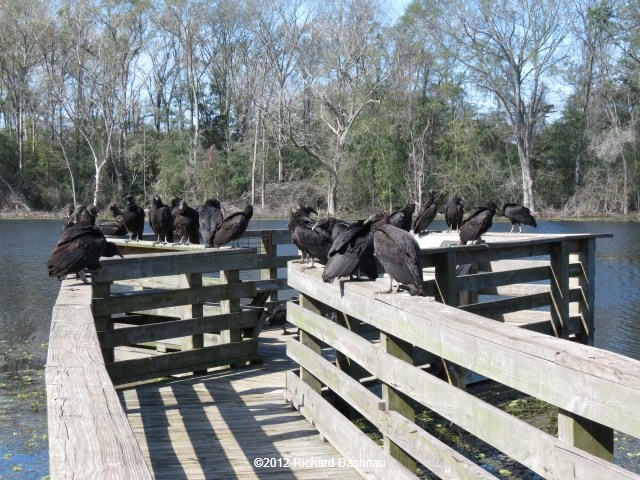 -
-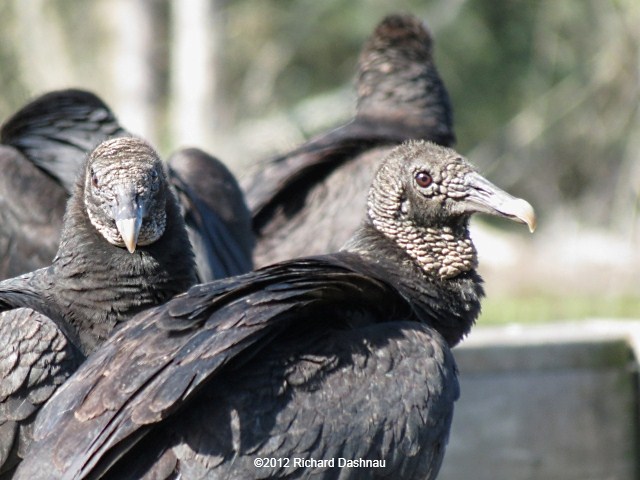 -
-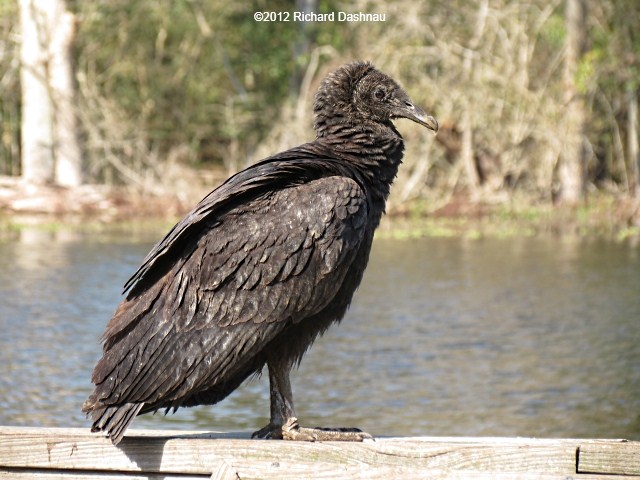 -
-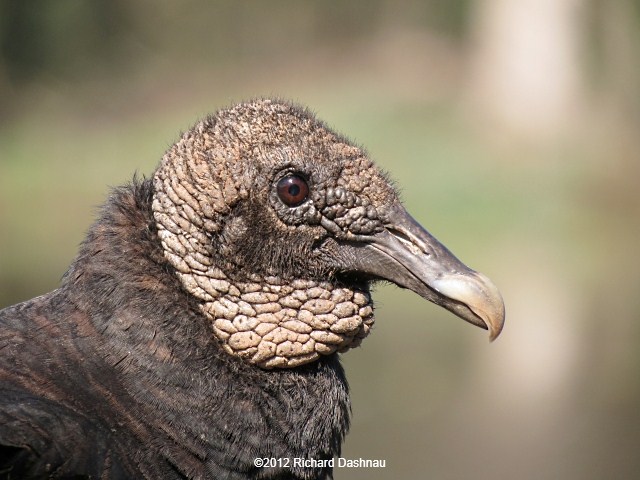 -
-
-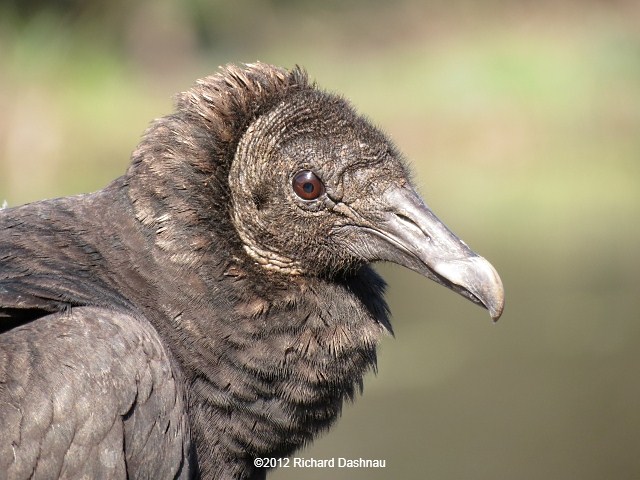
Some
flew off to the Vulture-filled tree across the lake. But some just
landed on the nearby island; which, I noticed, was covered with
Vultures. Many of them had their wings open and their backs
facing
towards the sun. What the heck were they doing?
--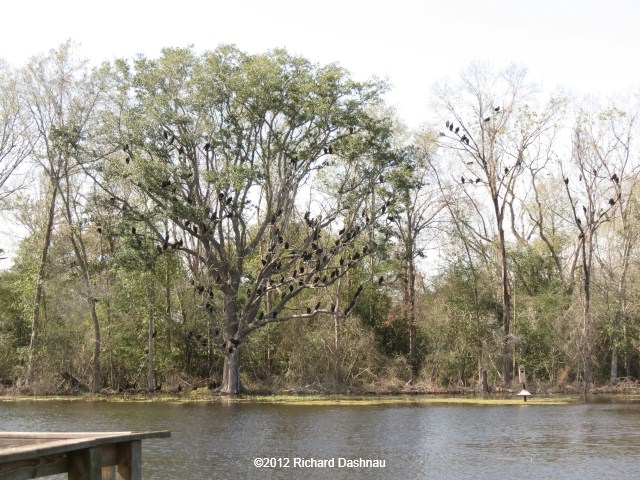 -
-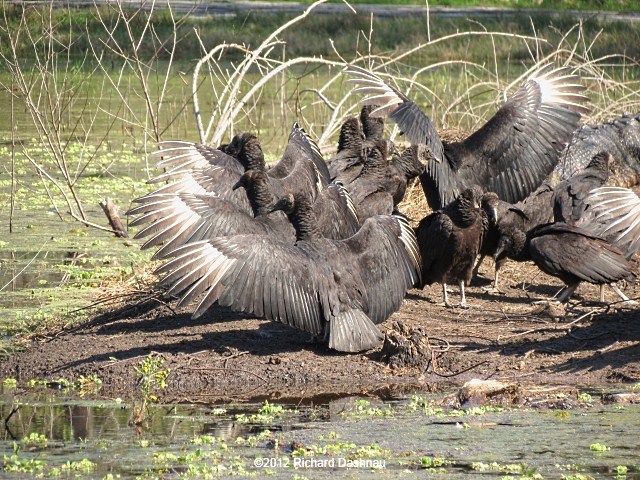 -
-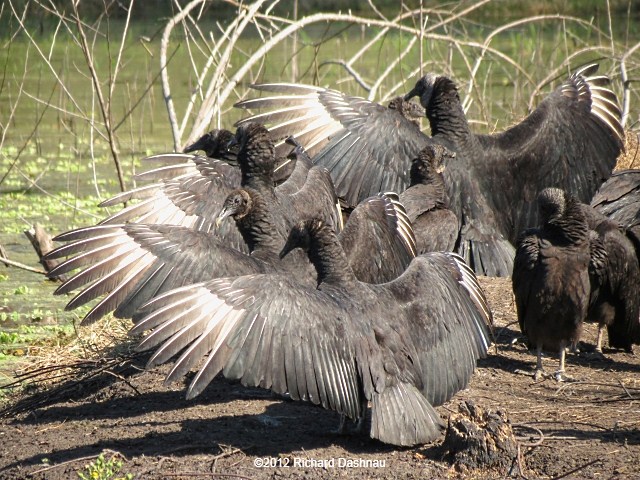 -
-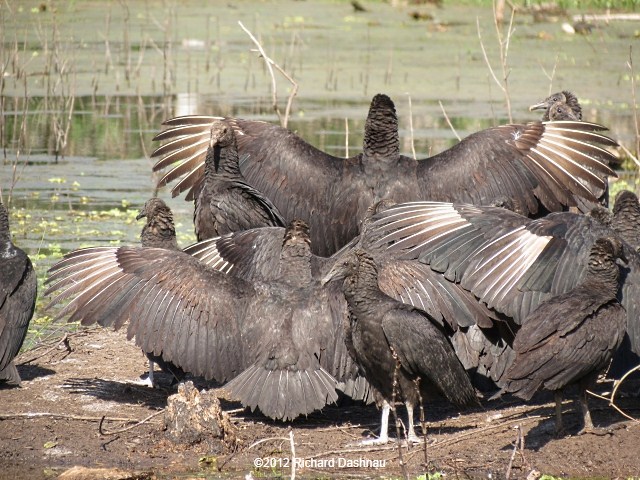
-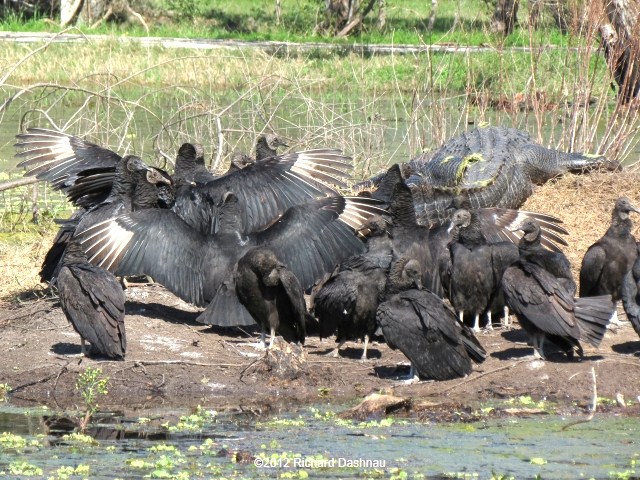
There
were also two HUGE alligators on the same island, but the Vultures
crowded on their portion and left the alligators to theirs.
--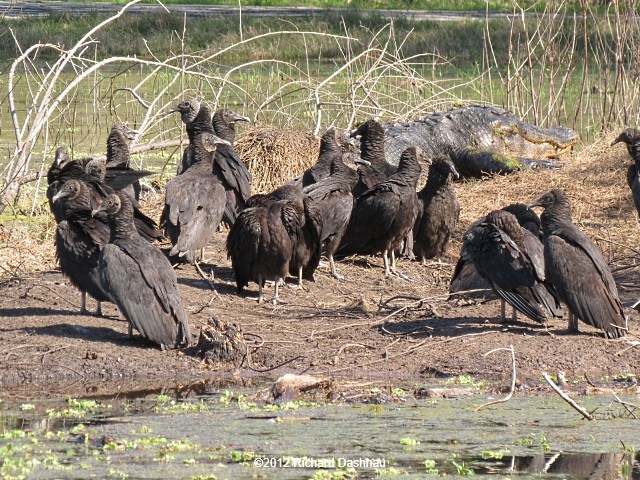 --
--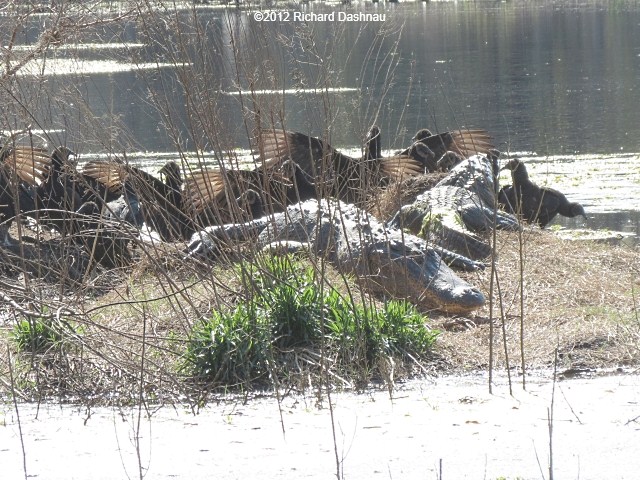 --
--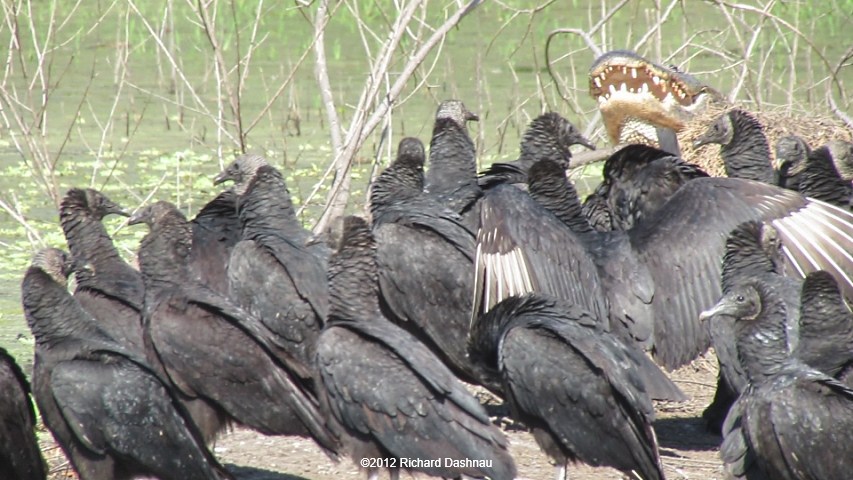 --
--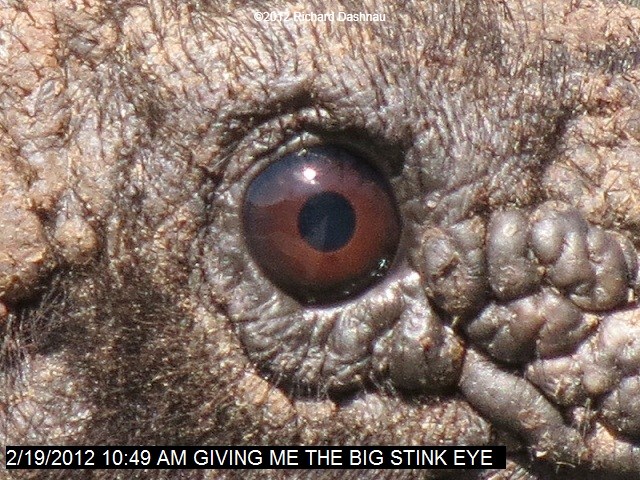
As
the park visitors and I watched the Vultures and the Alligators, many
folks asked what was going on. I noticed that Vultures landing on the
island were wet...very wet. So, they were drying themselves.
But
how were they getting wet? I finally found the answer through
my
binoculars. There were many Vultures in a large tree directly across
the lake from the end of the long pier. But under
the tree, protected by
distance and the heavy brush, the Vultures were
washing themselves! With all the Vultures I've seen at the park and
elsewhere, I'd never seen them washing themselves. This was done very
much like other,
smaller birds do in birdbaths and puddles everywhere.
--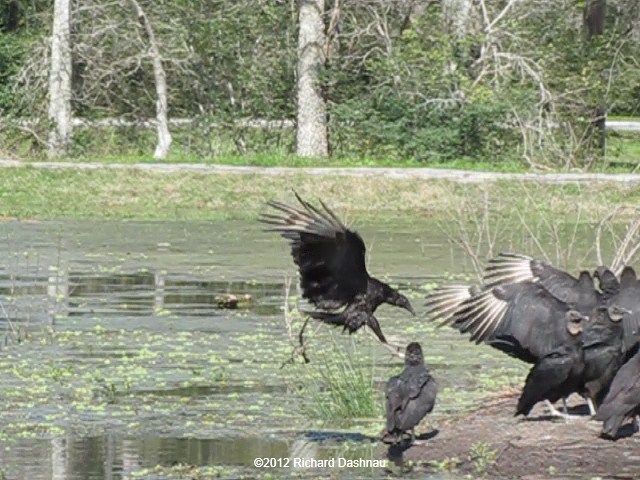 --
--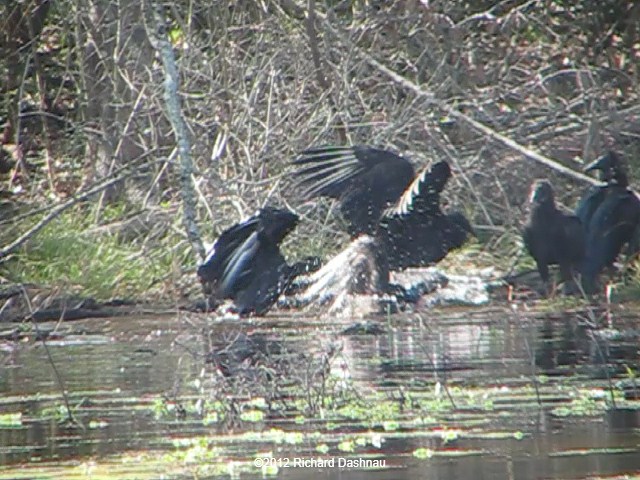
As
I watched through binoculars, I saw them wash their heads, dunk their
beaks, lie in the water, and "scoop" water across their backs with
their wings. After a few minutes of this, they'd fly
back to our
side of the lake and dry out. There they were, feathers clear, heads
clean, and legs poop-free. And I'd gotten to see another part of life
as a
vulture. Maybe now they'd be ready
for some social activity.
Along with the photos posted here, I was able to capture some
video clips (a few of the images here are frame grabs from
the
video). I've edited some them
together into this video
clip
(mp4 104mb).
January 22, 2012 While
walking past the water station at Elm Lake, I noticed a large group of
vultures on the ground between the trail and the lake. I thought this
was strange, so I moved
slowly towards them and observed what they were
doing. As I got closer, I noticed that 3 or 4 alligators were watching
the vultures, or whatever had caught the vultures' attention. The
vultures
nearest the water were watching the alligators. The alligators
seemed to be paying attention to the vultures. Then, some of the
vultures near the alligator started pulling at the grass and poking
the
ground with their beaks. Occasionally they seemed to be tossing grass
or dirt towards the alligators. This "standoff" continued for some
time, but was finally broken off when a park visitor
rode a bicycle
past the flock of vultures. The vultures flew off, but just to the
nearest island on Elm Lake. When I examined the ground where the
Vultures had been gathered, I couldn't see or
smell anything dead. The
images below are photos and frames from video clips that I shot of the
events I describe. I've edited two video clips from this. The
pictures show below, and
the video
clips are here
(45 mb mp4) and
here (52 mb mp4).
--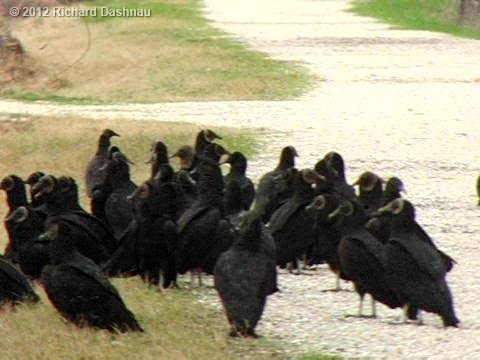 -
-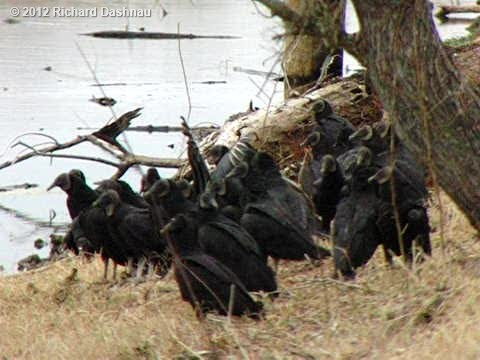 -
-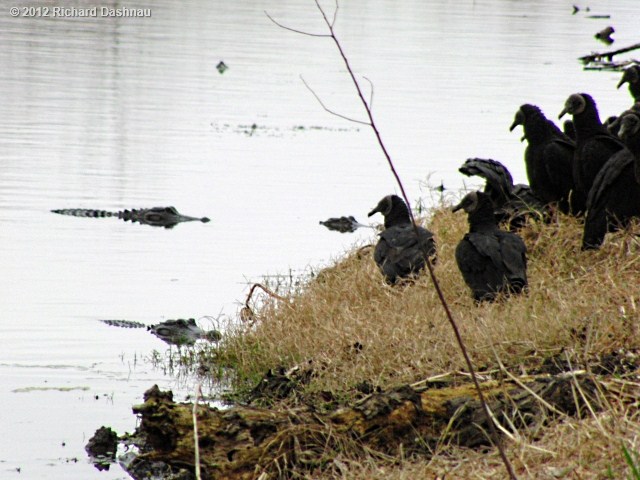 -
-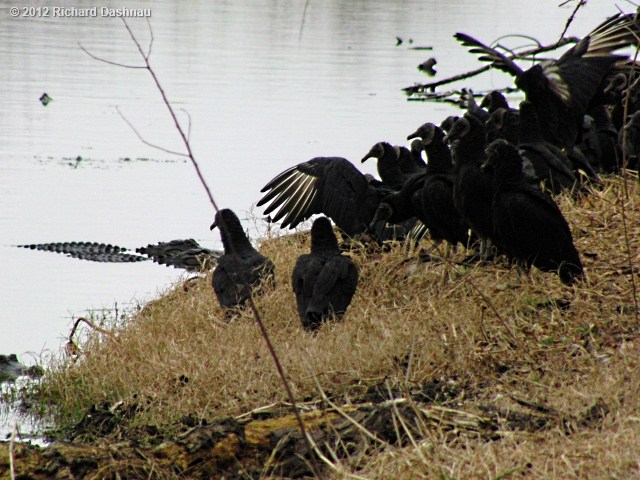
-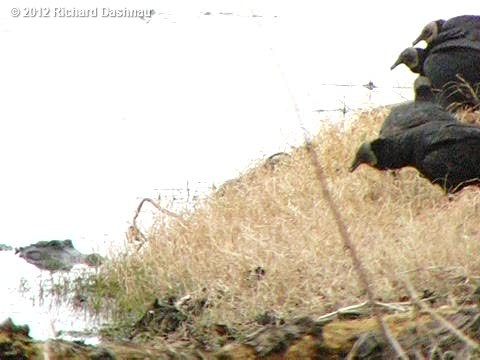 -
-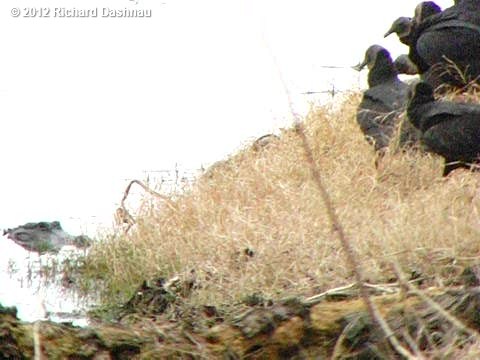 --
--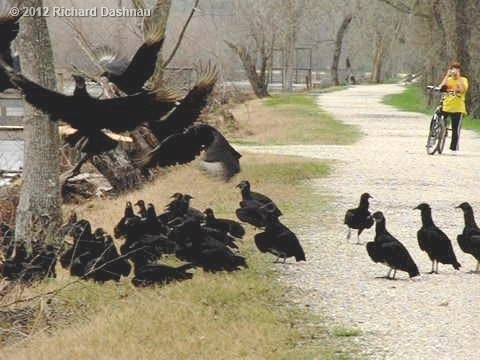
A
few hours later, I found out that an alligator or alligators had been
chewing on the carcass of a feral hog for at least a few days. The
alligators in the area of Elm Lake between pier 6 and
pier 5 were
moving around a lot--swimming back and forth between the islands and
the banks near the trail. While looking down the line of islands, I
noticed a large alligator standing on one
of them, chewing on something
large. I'd found the alligator with the carcass! I hurried
over in
time to see the alligator on one of the islands, alone, tossing the
carcass, and then crushing it--
as alligators do with large prey that
has bones. A vulture landed on the island, near the alligator. Then
another vulture. And another...and more until a group of vultures
surrounded the alligator.
The
vultures slowly moved closer to to the
alligator...starting to crowd around it. The alligator stood
up
with the carcass (actually just the head of the hog), and high-walked
into the water.
As
the alligator swam away, the vultures began picking at the dirt and
grass where the alligator had been holding and shaking the hog
carcass.
It seemed that fragments or even just droplets from the carcass
caused the area to smell like dead hog--and the vultures (and
alligators) were attracted to this.
Meanwhile, the other alligators tried to take the hog's head from the
alligator that had it.
--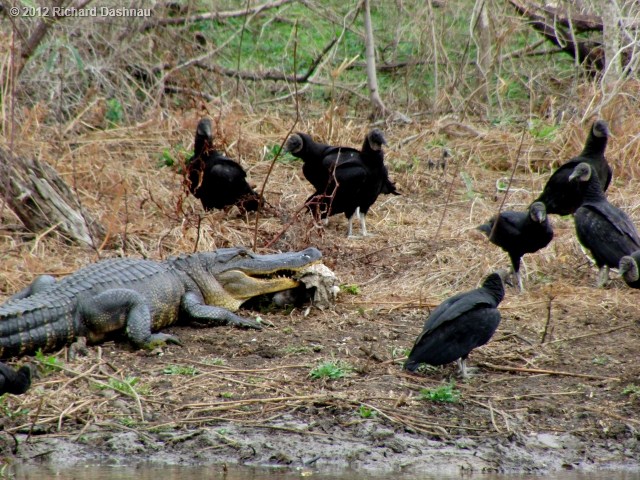 --
--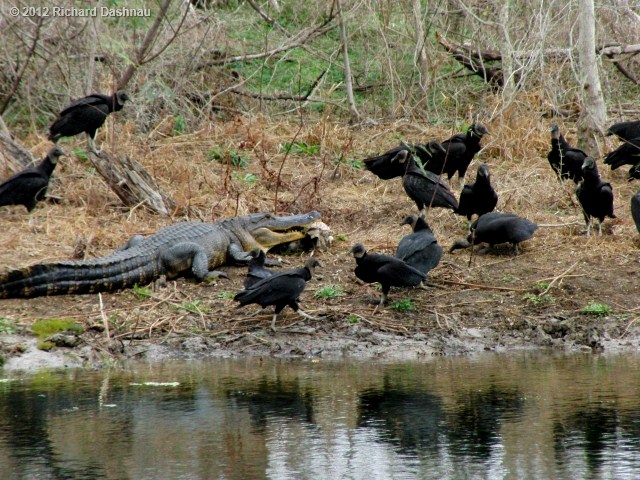 --
--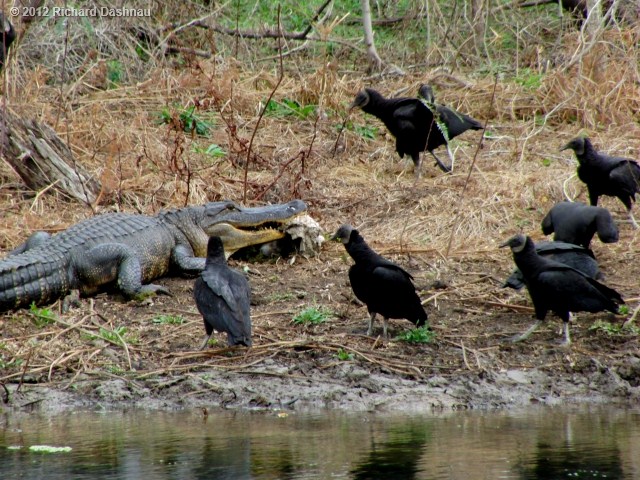
--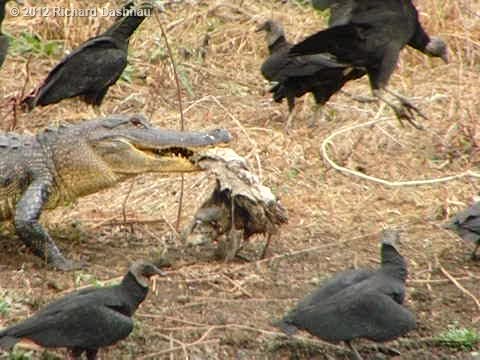 -
-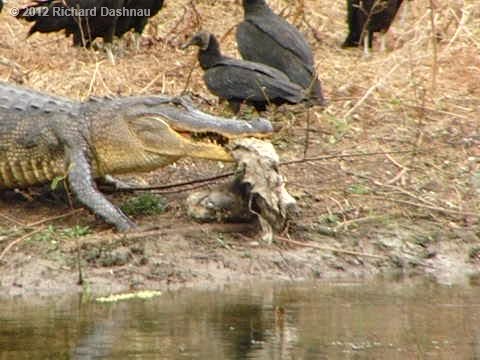 -
-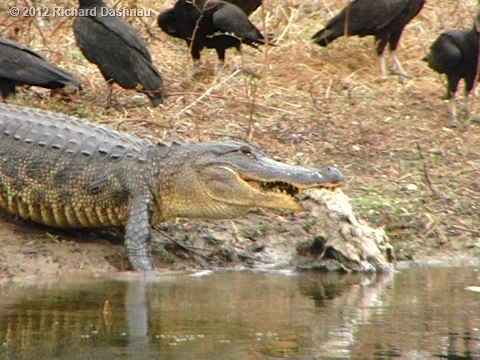 -
-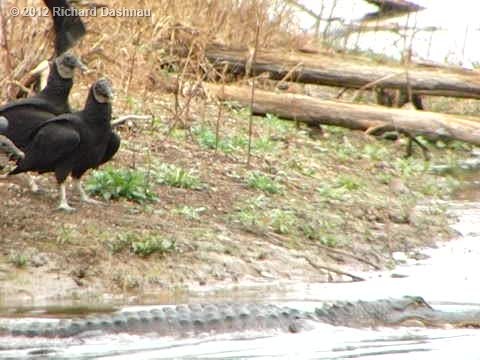
-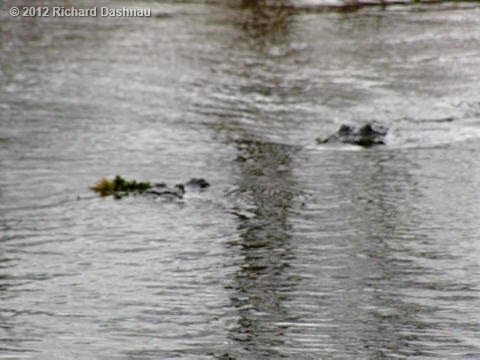 -
-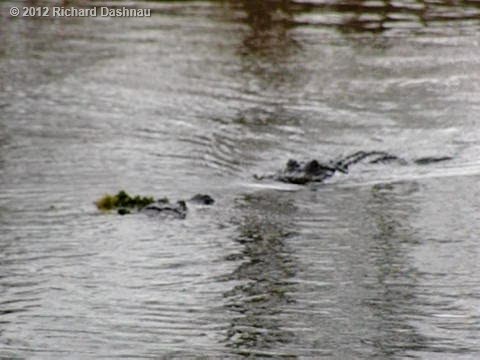 -
-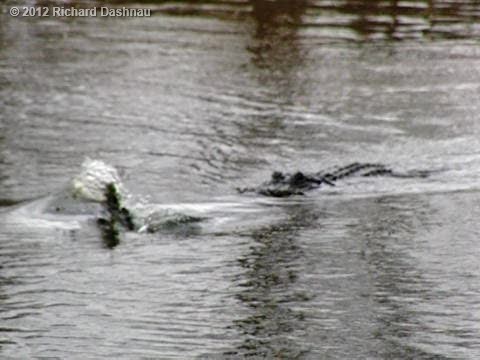
However,
that alligator was able to submerge and confuse the carcass thieves.
It
climbed up onto another island to try again to swallow the hog's head.
Again, it chomped on the hog. And then
the vultures landed on the
island, and gathered around the alligator. One by one the vultures
sidled closer to the alligator. While the alligator was resting after
a
bit of chewing, some of the
vultures moved in and grabbed at the hog's
head while it was still in the alligator's mouth! They actually pulled
a piece off the head before the alligator moved into the water again;
where it was
chased by the other alligators. Finally, the alligator
moved around the end of one of the islands, and was able to almost
close its jaws entirely around the remainder of the hog. The
vultures
stopped harassing it, and the other alligators couldn't see it.
The
Black Vulture (Coragyps atratus) is called "New World" vultures, along
with the Turkey Vulture (Cathartes aura). Recent studies have
genetically and morphologically linked these vultures to
the Storks.
One study can be found here:
http://www.pnas.org/content/91/11/5173.full.pdf That is,
Black
Vultures are related to Storks, such as the Wood Stork. Besides
certain
physiological
similarities, the two types share some behaviors--such as
"urohidrosis (or urohidrosis). This is the act of wetting the bare
surfaces of the legs with liquid waste in order to allow the
evaporation
of the waste to cause cooling through the skin.
Addition
2/25/2012:
After
further thought, I realized that Black Vultures might also be
called kleptoparasites. (I mention kleptoparasitism in relation to
spiders on this
page).
A "kleptoparasite" is an animal that will
supplement its diet by
stealing food procured by other animals. According to The Sibley Guide
to Bird Life and Behavior, Black Vultures can "dominate Turkey
Vultures
at carcasses" (page 185),
driving them off of kills that the Turkey
Vultures find with their greater sense of smell and more efficient
soaring abilities ("light wing-loading" (page 185)). As shown
here, the Black Vultures are
stealing food from the alligator as well.
--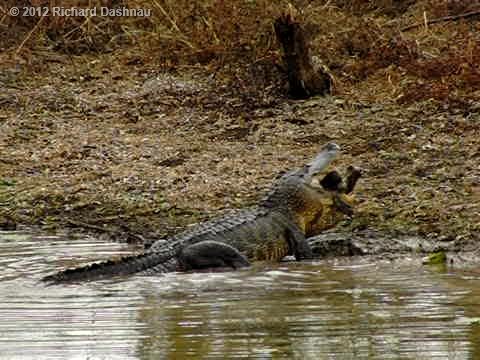 -
-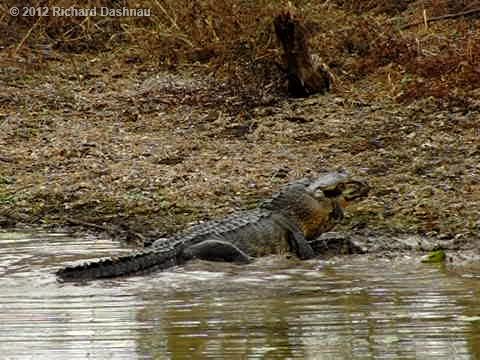 -
-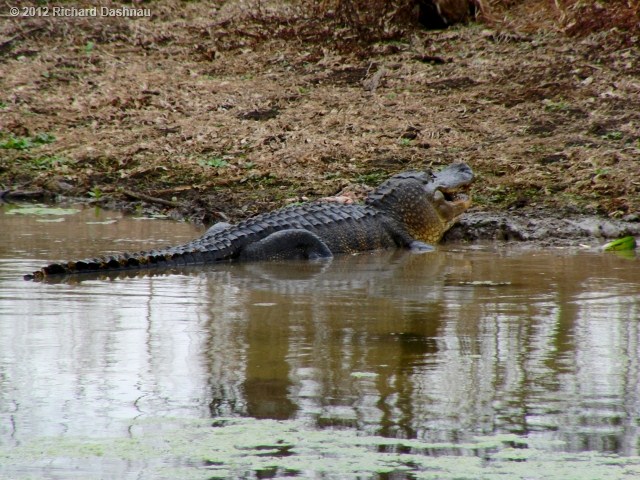
-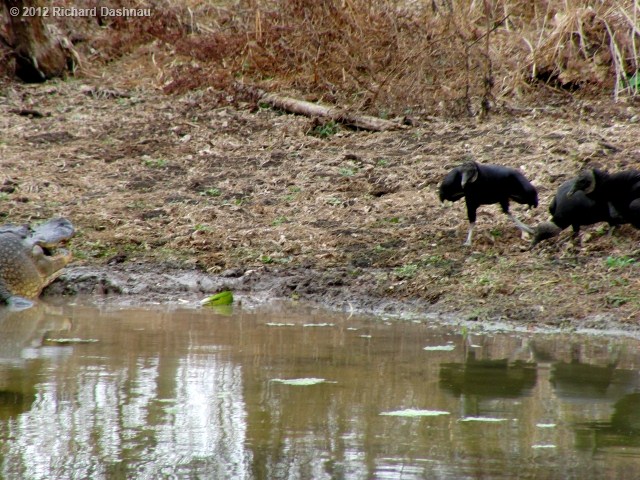 -
-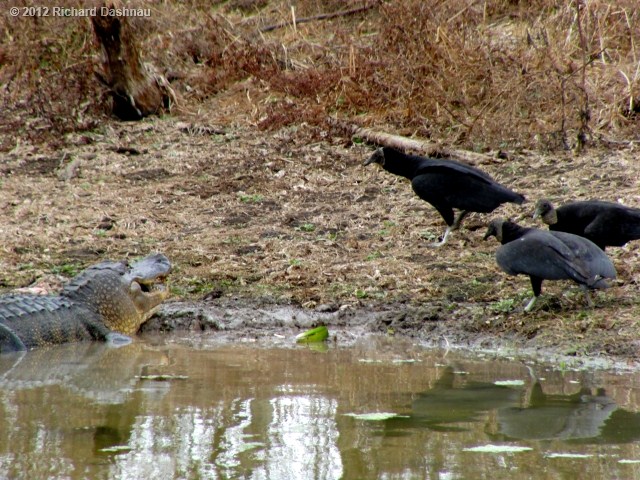 -
-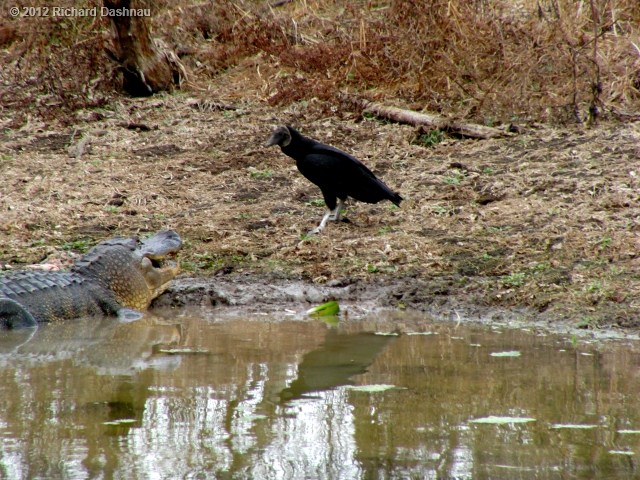 -
-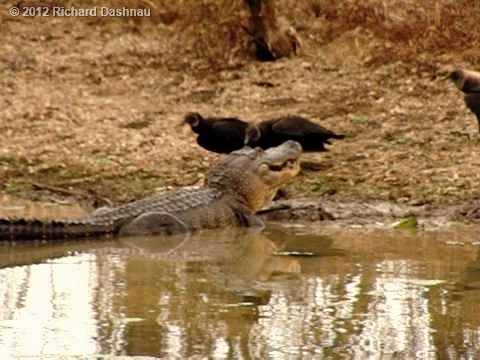
-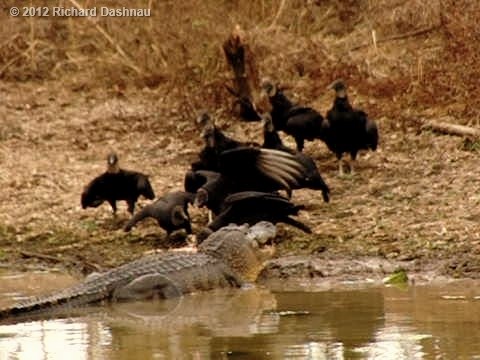
-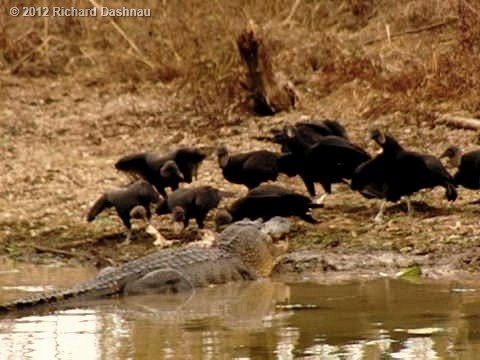 -
-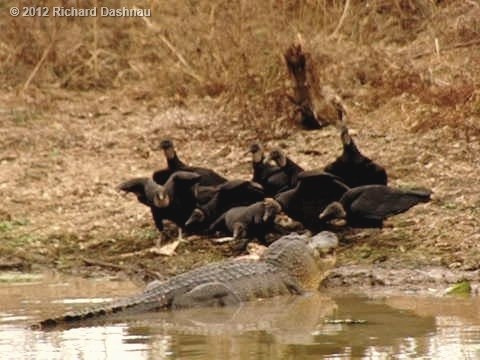 -
-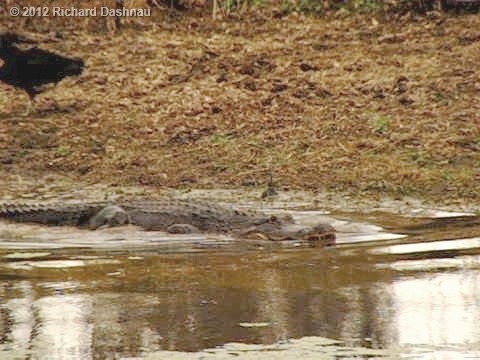 -
-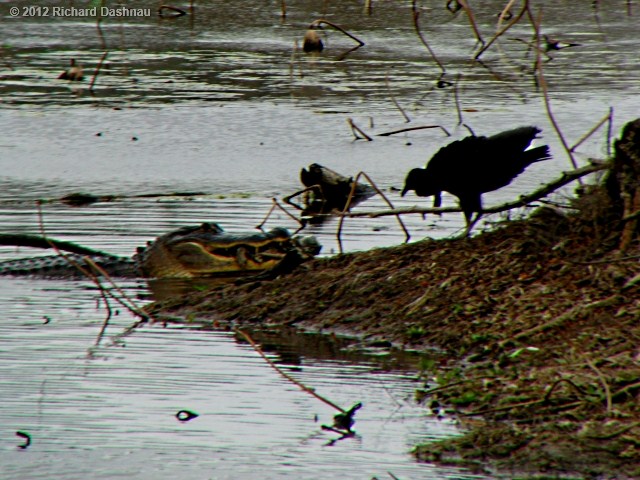
-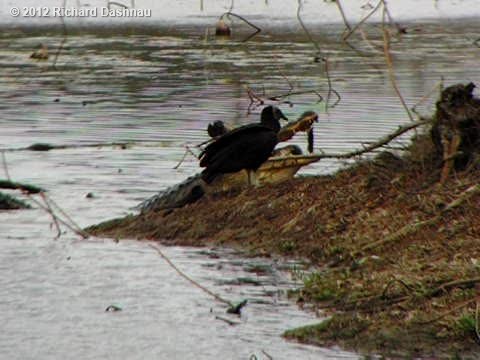
If you'd like to know more about the park
follow these links:
Brazos
Bend
State Park
The main page.
Brazos
Bend
State Park Volunteer's Page The
volunteer's
main page.
Go
back to my home page, Welcome
to rickubis.com
Go
back to the RICKUBISCAM
page.
Go
back to the See
the World
page.









































 -
- -
- -
-












 -
- -
-



 --
-- --
--

 -
- -
-



 -
- -
-

 -
- -
-


 -
- -
-
